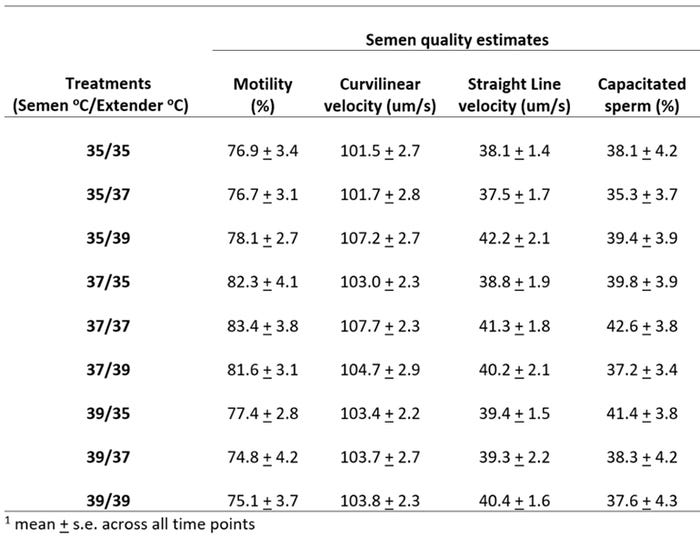Changes over time consistent with aging spermatozoa were observed in all treatments and there was no interaction between temperature treatments and individual boars.
September 25, 2018

By S. Crowell and W.L. Flowers, North Carolina State University Department of Animal Science
A common recommendation with regards to making insemination doses is for the temperature of the extender and neat semen to be within 1 C (or 2 F) of each other before they are mixed in order to prevent temperature shock to spermatozoa. However, the temperature of boar semen is usually between 34 and 39 F during ejaculation/collection and the normal body temperature range for estrous sows is 37.5 to 39.5 C. Consequently, it is likely that during a natural mating, spermatozoa are exposed to temperature differences greater than 1 C.
Based on this observation a study was conducted to re-evaluate the effect of temperature differences between the extender and neat semen at the beginning of the extension process. Ejaculates from 11 boars collected over 26 consecutive weeks were used in the study. After collection, one-third of each ejaculate was either warmed or cooled more than 30 minutes to one of three temperatures: 35 C; 37 C or 39 C. After the temperature of the neat semen had stabilized, a portion within each temperature group was extended with a five-day extender at the same temperatures: 35 C; 37 C or 39 C.
The extension process used for each combination involved adding one-third of the extender volume sequentially over a 30-minute period. This created nine different treatments. Three control treatments for which the extender and neat semen were the same temperatures: 35/35, 37/37 and 39/39. Three treatments for which the neat semen was cooler than the extender: 35/37, 37/39 and 35/39 and three treatments for which the neat semen was warmer than the extender: 37/35, 39/37 and 39/35.
The rationale behind these treatments was to mimic temperature differences that might be inherent to natural matings. Various estimates of semen quality were taken immediately prior to and at 30 minutes, 24, 48 and 96 hours after extension. The split ejaculate technique was used so each collection from each boar served as its own control. This resulted in 286 observations for each treatment at each time point.
Selected estimates of semen quality and sperm function are shown in Table 1. There were no significant effects attributed to temperature differences between the neat semen and the extender at the time they were mixed.

Table 1: Effect of temperature differences between extender and neat semen on selected semen quality estimates1
Changes over time consistent with aging spermatozoa were observed in all treatments and there was no interaction between temperature treatments and individual boars. While the longstanding recommendation of having the neat semen and the extender at the same temperature before they are mixed is an excellent one and should be followed these data indicate that spermatozoa may be more resistant to temperature shock during extension than previously thought, at least when temperature differences are between 2 and 4 C.
You May Also Like



